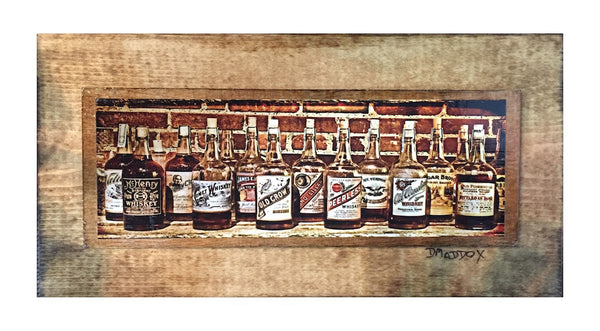Bourbon Art in Contemporary Society: Where Custom Satisfies Innovation
Bourbon Art in Contemporary Society: Where Custom Satisfies Innovation
Blog Article
Catching the Significance of Scotch Art Through Distinct Aesthetic Depictions and Styles
The art of whiskey prolongs past the fluid itself, showing up with a variety of aesthetic depictions that encapsulate its storied heritage and craftsmanship. What remains to be revealed is how these developing designs show not just the bourbon itself but likewise the transforming landscape of artistic analysis. Limited Edition.
The Background of Bourbon Art

As bourbon production spread, so too did the desire to elevate its experience via art. From the detailed inscriptions on early barrels to the sophisticated labels of modern-day bottles, each element shows a special imaginative vision, functioning as an aesthetic narrative of the bourbon's heritage.
In the 18th and 19th centuries, the increase of the commercial change further enhanced whiskey art, leading to cutting-edge product packaging and advertising that captured consumer focus. Developers and artists started trying out appearances, imbuing whiskey-related images with symbolic significances that conveyed concepts of neighborhood, workmanship, and custom.
Today, bourbon art continues to evolve, mixing typical approaches with modern art types. Limited Edition. This continuous discussion between the spirit and its aesthetic representation highlights the long-lasting bond in between bourbon and culture, enhancing the overall experience for fanatics worldwide
Iconic Bottle Layouts
While many variables add to the appeal of whiskey, iconic container layouts play a critical function in forming consumer assumption and enhancing the overall experience. The visual discussion of whiskey containers is not merely a visual factor to consider; it functions as a bridge in between the customer and the product, evoking emotions and setting assumptions.
Distinct forms, materials, and closures can raise a bourbon brand name's identity, making it immediately identifiable on crowded racks. The classic Glenfiddich container, with its elegant conical shape, conveys a feeling of practice and craftsmanship, while the strong, modern layout of the Balvenie bottle shows development and class. The usage of colored glass or special textures can recommend the high quality and character of the whiskey within.
Iconic layouts commonly integrate aspects of cultural heritage, signifying the brand name's history and connection to its roots. Brand Names like Jack Daniel's use a simple, durable style that resonates with its American scotch heritage. Ultimately, the impact of container style extends past mere capability; it encapsulates the essence of the brand, inviting consumers to indulge and discover in the abundant tapestry of whiskey culture.
Label Artwork and Branding
Container layouts often set the stage of what customers can expect, however tag artwork and branding play a just as considerable duty in communicating a scotch's identification. The label functions as the initial factor of get in touch with between the product and the consumer, enveloping the significance of the scotch within its aesthetic elements.
Reliable tag artwork combines images, color, and typography to create a story that resonates with the brand's heritage and target audience. A label featuring elaborate pictures and vintage fonts might evoke a feeling of practice and craftsmanship, appealing to aficionados. On the other hand, vibrant colors and modern style components could bring in a younger demographic seeking innovation and enjoyment.


Digital Photography and Visual Storytelling
Recording the significance of bourbon via digital photography and aesthetic storytelling is an art form that elevates the brand name experience. This tool goes beyond mere item depiction, diving into the detailed narratives that surround each bottle. By using compelling imagery, professional photographers can stimulate emotions that reverberate with consumers, ultimately building a deeper connection to the scotch brand.
Visual storytelling in scotch photography typically uses rich appearances, lights, and structure to highlight the distinct characteristics of the spirit. The interaction of light and shadow can accentuate the brownish-yellow tones of scotch, while the selection of history aspects-- such as rustic barrels or stylish glasses-- can reinforce the brand's heritage or lifestyle organizations.
Additionally, catching the ceremonial aspects of bourbon usage, from the putting to the tasting, welcomes viewers into a sensory experience, permitting them to think of the tastes and scents that await. Each picture not only showcases the product yet likewise narrates of workmanship, practice, and the moments that whiskey can boost - Realism Art. Hence, photography comes to be a powerful device in articulating the identification of whiskey brand names, positioning them within the more comprehensive cultural landscape
Emerging Trends in Bourbon Art
The advancement of whiskey art is increasingly shaped by contemporary patterns that mirror more comprehensive social changes and consumer choices. This change not just highlights the value of sustainability yet additionally improves the narrative bordering whiskey production.
Furthermore, digital art has surged in popularity, enabling ingenious representations of scotch. Artists are leveraging innovation to craft immersive experiences, such as enhanced reality installations that involve visitors and give a much deeper understanding of scotch's cultural importance. This pattern likewise encompasses social networks platforms, where visually striking content garners attention and cultivates area amongst lovers.
Additionally, collaborations between bourbon brand names and artists are becoming more widespread. These partnerships produce limited-edition Whiskey Art packaging layouts and unique artworks that celebrate both the craftsmanship of whiskey and the creativity of musicians. As scotch art continues to evolve, these arising fads will certainly form its future, promoting a dynamic intersection of society, sustainability, and innovation within the whiskey area.
Conclusion
In conclusion, the art of bourbon incorporates a diverse range of graphes that reflect its abundant heritage and workmanship. From renowned container layouts and complex tag art work to engaging photography, each component adds to a broader story that enhances the customer's experience. As arising trends, such as electronic art and sustainability, remain to form this artistic landscape, the diverse identification of scotch continues to be an enduring resource of cultural connection and expedition.

In final thought, the art of bourbon includes a varied variety of visual representations that mirror its abundant heritage and workmanship.
Report this page